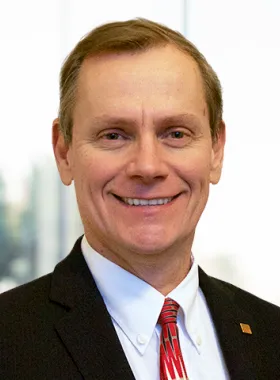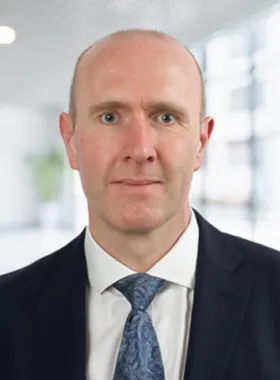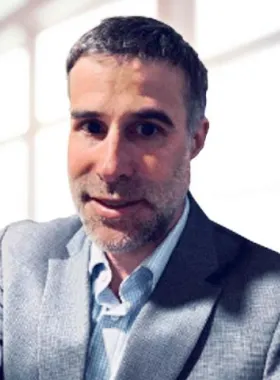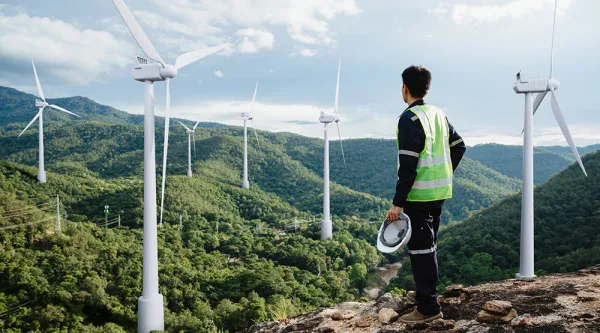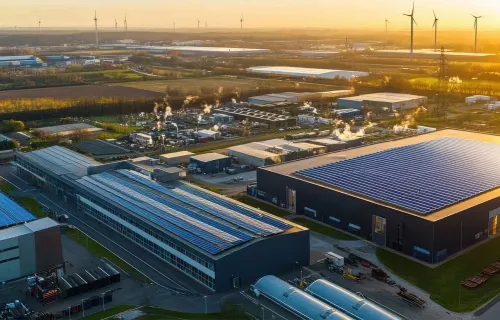With several market dynamics at play, geopolitical and economic uncertainty, and climate change a top global priority, making one blanket prediction of the future of the energy market is fundamentally hard. Rich Hampshire suggests taking a local-to-global view and assessing the current status and development of local markets to understand the future direction.
Peter Warren agrees that challenges vary by region, so “carte blanche" predictions of the market aren’t feasible. He notes, for instance, that Australia has high solar penetration, but very low electric vehicle (EV) penetration. Whereas in countries like Norway, it's the other way around.
Another challenge, says Rich, is the speed of new technology development. "We don't necessarily understand what the learning curves for some of these technologies will look like."
What is certain, however, is that the future will see a more diversified energy market. "I don't think the swim lanes are going to stay the same," says Peter. He cites examples of a Spanish energy company that now produces hydrogen for industrial use and others in Norway that are considering converting abandoned herring processing factories to produce hydrogen.
Ultimately though, says Rich, it comes down to economics and investment. "I think it will become far more of a strategic business decision around where companies choose to place their bets."
Non-traditional market actors add to the complexity. For instance, Peter says compressed air and hydrogen manufacturers are now moving to compete against energy companies. Rich adds that automotive manufacturers see an opportunity to extend their service offerings and customer relationships with electric vehicles.
So, while there are challenges, there are also opportunities for both traditional and non-traditional market players. "I can see there being real opportunities here in terms of how they (downstream oil and gas businesses) reconfigure the filling station market for EV charging," says Rich.
These changes will require businesses to adapt quickly and, in many cases, change their business models. Peter shares how a company plans to build a completely separate IT department to handle their hydrogen versus their natural gas. And why? "It's an opportunity for them to go new, lighter, innovative, but also, if the regulator says you've got to split the company apart, they could," he explains.
As the market gets more complex, there is a greater need for standardization and data to support investments, efficiencies, interoperability and scale. Adoption of TCFD recommendations, says Matthew Ayearst, will standardize a lot of the reporting and bring the kind of transparency investors want.
Calling TCFD a "game changer," Rich says its implications for the ability to access capital, win customers, enhance or impact reputation, and trigger investor action make it instrumental in moving climate risk onto the board agenda.
Climate-related disclosure is also about opportunities. "There's a lot of money that is very interested in a non-carbon-based economy," says Matthew. Sustainable finance will catalyze the activities and interest toward a greener, cleaner economy. He explains that some of these products allow companies to embed their sustainability goals into the actual bond or loan to continue receiving finance. Companies also receive a discount on the financing—called the "greenium"— as a benefit of investing or getting investors to invest in green projects.
There is a social responsibility and reputational element to consider as well. "We see people building residential communities here in Canada. One of our clients is starting at 20% hydrogen and has a plan for a fully hydrogen-powered new subdivision," says Peter.
Almost everything boils down to having comprehensive, good-quality data. "Data is going to provide the confidence that investors need and the transparency that will allow projects to be measured and have metrics, which pushes the science forward, pushes the projects forward and pushes the financing forward," says Matthew. Peter agrees: "When we talk to our data scientists, it's all about having the ‘data to trusted action.’ In other words, you have to have data that is not necessarily perfect, but good enough to do the trusted action."
However, gaining this level of visibility requires global interoperability of systems, reporting standards and data. "People need to be able to have confidence that they understand the data that they're receiving, and that it is produced on similar bases so they can take such risk-weighted decisions," says Rich.
Here's where policy and regulation play a key role. "Making sure that the policies, regulations and market rules within each territory or in each region and how performance is going to be measured are clear will start to help people understand what are the data requirements to inform those sorts of decisions," says Rich. This is also essential to support an evidence-based policy approach.
Accelerating progress calls for collaboration between policymakers, regulators, businesses and their suppliers. "Policymakers and regulators are key stakeholders and influencers in the market as much as the businesses are. And I think we must move to more collaboration rather than seeing it as ‘us and them,’” says Rich. He adds that some policymakers and regulators are already proactively identifying challenges to action or investment and trying to address these to accelerate nation-states' or businesses' journeys to net zero.
Matthew cites the example of the U.S. Inflation Reduction Act, which directs nearly $400 billion toward decarbonization. "To me, it's indicative of how nation-states are seeing the opportunity in this for economic security and growth and high-value, high-skill jobs in the future," says Rich.
Moving away from thinking of it as an overhead to an opportunity is critical for progress. "As people look at the (green) economy as an opportunity as opposed to an expense, and ESG as a new business opportunity as opposed to something that's being done to me, I think things are going to shift," says Peter.
- 1. Introduction
-
Matthew Ayearst:
It's my pleasure to be here today from CGI to introduce to you and to moderate a conversation on the future of the energy market and climate-related disclosure. I'm Matthew Ayearst, and I'm the Director of Sustainability for ESG and Sustainability Consulting at CGI. And today, I have with me two guests from CGI. I have Rich Hampshire from our UK office. Rich, would you like to introduce yourself, please?
Rich Hampshire:
Thanks, Matthew. Hello, everyone. I'm Rich Hampshire. I work for CGI's UK and Australia operation, primarily working with our utilities clients on various aspects of the energy transition.
Peter Warren:
Hey, Matthew, thank you very much. So, hi, everyone. I'm Peter Warren. I'm the lead for what we do in energy and utilities from a strategy standpoint globally. That's all things oil and gas right through to all things utilities, including water and wastewater and all elements of that.
Matthew Ayearst:
Thanks, Peter. So, I'd kind of like to start the conversation off sort of broadly. So, Rich, where do we really see the future of the energy market?
- 2. Future of the energy market
-
Rich Hampshire:
I think that's a really key question, Matthew, and it's one that I think we need to unpack a little bit in that you used the term singular, energy market. And certainly, when we talk about the transition in the electricity market and the downstream gas markets, those are subject to far more local or regional regulation and policy drivers.
So, I think it's really important when we think about what's happening in the future of energy markets, we think about those local markets, what's their starting point? What's their current level of energy security, their current level of indigenous energy production? What do they rely on? What's the age and the residual life of existing assets, for instance? Because one of the things that's key to this is as we go through the energy transition, we want to minimize stranding of existing asset investments. So, all of these things need to be considered and we need to look at it on a market-to-market basis. And indeed, in Peter's case, over there in Canada there are multiple markets. Pete, do you want to perhaps talk around some of that?
Peter Warren:
Yeah, Rich, I completely agree with you. I think what I see when I look at not just here in Canada, but around the world, everybody's got different problems, and the markets are at different maturity levels. I was very well-educated by one of our Australian clients the other day. And there's a great podcast out now, right now, by another company. I'm just fully charged on the Australian market and just how much they have solar penetration, yet they have very low EV penetration. Whereas in Europe and Norway, they have the inverse.
At the same time, I don't think anybody's really staying in their same swim lanes anymore. So, we have companies like Iberdrola making hydrogen. We have a company in Norway that's being started up by people buying old herring factories to make hydrogen on the shorelines. So now that the gas lines are going to have to deal with hydrogen injection from different points, when we talk to the gas distribution companies, they're now looking at what they do here.
So, I think you're right about it's going to be different energies. We've had a monopoly for a while. It's been electricity, it's been gas, and it's been petroleum products. And you go here when you have this use case, like your vehicle needs to move, you go to the petroleum station, the gas station, you fill up. That's all changing. I don't think the swim lanes are going to stay the same, and I think that the energy markets are going to have to be flexible to reflect that.
- 3. Diversification and the new energy mix
-
Matthew Ayearst:
I was going to ask you both, really, we're in a kind of a transition period right now, and where do you see the energy mix going with regards to the market itself?
Peter Warren:
Yeah, I can jump into that. I think it's going to, again, depend on your starting point to Rich's thing. If you started from a petroleum background, you may be thinking one way, but at the same time, we see the big petroleum folks investing billions into electrification.
I like listening to people on different things, it's absolutely going to be this, or the trouble with this is it won't work. It's usually based on a regional point of view. So, I don't think that we can actually say what's going to be carte blanche across the market. But Rich, you're UK and Australian views, what do you think about that?
Rich Hampshire:
Yeah, I think I broadly agree, Peter. I think the challenge with some of this stuff is, we are developing new innovative technologies, new innovative techniques all the time, and we don't necessarily understand what the learning curves for some of these technologies are going to look like. Even if we go back 10 years and we look at the cost of solar and wind, well, the costs today are vastly lower than was being projected 10 years ago. So where will it be in another 10 years, and where will it be by 2050? Similarly, with battery and storage technologies.
Ultimately, I do think it comes down to economics and investment. And I'm an engineer with a specialism in energy as a background. But I guess what I've learned over the last 20 years is nothing happens unless the finance starts to move as well, which is why I'm really interested in some of the triggers and some of the work that has been going on to help accelerate investment into green technologies.
Matthew Ayearst:
I'd really want to, yeah, let's explore that a little further in a second. I just want to sort of summarize. So, what I'm getting from this is that we're going to really look at a more diversified energy market in the future, and some of these larger firms, particularly the firms that dominate the energy market, so the petroleum companies are going to have to become more diversified and really support some of these sort of fledgling industries that are starting to really take off, like hydrogen, biofuel. Is that correct?
Rich Hampshire:
Yeah, I think so. I'd probably frame it more as opportunities. There is going to be more diversification in fuel, so I think it will become far more of a business strategic decision around where companies choose to place their bets in terms of do they focus primarily on hydrogen? Lots of debates go on. Peter and I have lots of debates around the economics of hydrogen and where hydrogen may have a role to play.
And then there's the debate around how long traditional gas will be around, gas mixed with hydrogen? What's the role of electricity? How much will go through electrification? What are the potential infrastructural limitations and constraints to supporting that? It's all too easy to think that there aren't any constraints or assume there are no constraints, but the reality is we're probably going to need to build an awful lot of infrastructure as well.
- 4. New market disruptors, business models and revenue streams
-
Matthew Ayearst:
In the news, oh sorry, I just sort of saw in the news this week a very large airline announced a very, I think it was $100 million investment in sustainable fuel. And so, my question was really in reaction to kind of this future, how are companies sort of adapting?
Peter Warren:
Yeah, maybe I can take that on. I think that people, again, there's a great book a few years back called Blindsided. And I don't think people can look at their traditional competition and say it's going to be the guys I knew before, the gals, the people I knew before that I'm going to compete against. So, we see people that manufacture compressed air and hydrogen as a manufacturing company moving in to compete against the energy companies. They see those large firms as their competition.
So, we actually know that people are changing their swim lines, airlines investing in energy, biofuel companies moving forward. The supply chain is going to be disrupted. And back to Rich's point is they're doing this because there's math there, there's money there. And some of these people have first-mover positions because they're coming in with Industry 5.0 thinking against regional competitors that may be very much caught up with some real realities of what is this new chemical that I'm going to put in my pipelines going to do to my actual metal pipelines? They have different concerns at different levels, and they're under different regulations.
Another client we have is going to build a completely separate IT department to handle their hydrogen from their natural gas. And why? It's an opportunity for them to go new, lighter, innovative, but also, if the regulator says you've got to split the company apart, they could.
So there's a lot of people dealing with different things based on their regionality and where they see the competition in market. Either one of you got a comment on that or a thought?
Matthew Ayearst:
Yeah, I didn't really consider companies actually reconfiguring departmentally in order to adapt to this sort of new energy market. And that's a really interesting point with regards to the IT department. I thought that was very interesting.
Rich Hampshire:
I think, to build on Peter's points, Matt, there's a big piece here around non-traditional market actors coming in along the way of I think saying what Pete's just said. But what I'm talking about there is automotive manufacturers seeing an opportunity with electric vehicles to extend their service offer to their customers and extend their relationship with their customers. And that then looks very, very different to a traditional commodity, electricity or gas supplier into people's homes.
Equally, you can see the downstream oil and gas businesses having quite a different proposition to traditional electricity and gas suppliers in terms of how they might play into the market, how they use their filling stations, what they actually do in a similar way to what happened 20, 30 years ago when they all started putting mini marts onto their forecourts after supermarkets or hypermarkets had start putting forecourts in their car parks. They had to respond at that time, and they did. Equally, I can see there being real opportunities here in terms of how they reconfigure the filling station market for EV charging.
Matthew Ayearst:
That's interesting because, yeah, that's a very big business model change. And I know that some of the large oil and gas companies, they have some of the largest retail footprints. I know in this country, in Canada, for sure.
Peter Warren:
Yeah. And that's a major revenue stream for them. And if you're not going there to charge, now it changes the ma-and-pa local petroleum station. If you don't have to run out to fill up and you're also going to buy some groceries, one of their draws disappears, and then we see a shift happening there. And that's a concern.
When you look at these things about putting in EV charging from the car manufacturers, they're actually thinking they can put low-cost dumb chargers because all the intelligence lives in the car. The car determines when I'm going to charge. The car has the application inside of it. And so that impacts some municipal utilities and distribution companies because they would prefer a smart charger that they control that says when you're going to charge and when you're not.
So now you've complicated the market. You have to have a connection then effectively to every make and model of car with every manufacturer to figure out when it's going to come on and off because they're making the decision when they're going to charge separate from when you may or may not want that load on your network.
- 5. Impact of Task Force for Climate-Related Financial Disclosure (TCFD)
-
Matthew Ayearst:
That's interesting. So, I'm going to just pivot this conversation a little bit. So, you talked about, because what you touched upon right there is standardization. And part of the conversation we're having here is about climate-related disclosure. And so, I wanted to shift the conversation a little to the role that the TCFD has played, so to remind listeners, the TCFD is the Task Force for Climate-Related Financial Disclosure, with regards to incoming regulations in different jurisdictions, the incorporation of scenario analysis, and really forcing corporations to really consider the risks and opportunities that are related to climate.
And I think what we've really talked on a lot is about the opportunities. And the incoming TCFD adoption by a lot of jurisdictions will standardize a lot of the reporting, and a lot of the considerations companies are making in their disclosures. So, I was wondering if, Rich, do you have something to say about that?
Rich Hampshire:
Yeah. So, Matthew, I think when we first spoke, it was on this subject of TCFD and understanding how that is likely to impact on the boardroom. And as I mentioned earlier, the whole piece around how you mobilize investment is something that I've been looking at for the last 20 years in this space and how we accelerate it.
And I think TCFD's likely to be a game changer in that. It's going to firmly move climate risk onto the board agenda. And if it starts to affect the ability to access capital or secure business or even as we've seen over the last two or three years, investor action in terms of who gets placed on boards, all of these things are going to raise climate risk very much up the agenda.
And I think it's actually the next two to three years are going to be a really interesting time to see how organizations respond to these new regulations, these new reporting requirements, how they respond and work with and collaborate with their supply chains in order to show that they both have a credible plan to address their climate risk exposures and that they are on track against what they say and what they have committed to do.
Matthew Ayearst:
Yeah, I think transparency is a really big driver. And that's one thing the TCFD brings, because investors really would like to have more information in order to drive the decisions to invest. So, I think the TCFD is definitely something that's contributed to that, giving investors confidence in some of these more speculative startups with regards to clean energy and clean tech.
Peter Warren:
Yeah. And just to that point, another news article here in Canada was citing that a large majority of the C-suites major companies here now have ESG financial governance, et cetera, being tied to their bonuses. So, getting that data is going to be increasingly important. I like the quote, "Whatever interests my boss fascinates me." And I think these departments are going to be put under a lot of pressure to bring this data forward and have better tools and drive this thing along.
And maybe a question to you, Matthew. So, looking at this, does the money move differently in a carbon-based economy verse a non-based carbon-based economy in this new generation?
- 6. Sustainable finance
-
Matthew Ayearst:
Yeah. So, we already talked about opportunities and risks, and certainly, if we want to tie in the theme of disclosure, I think there's a lot of money that is very interested in a non-carbon-based economy. I think the smart money knows that we're, like we talked about earlier, to some extent, that we're looking at a much more diversified energy mix in the future.
And so, how does that money get deployed is a good question. And where does that money go is a good question because this is a horse race. We all know that. We don't know if people's houses on a residential basis will be using hydrogen or it will just be commercially based, if we'll be using more wind power residentially or natural gas or propane. So, it's definitely a horse race.
So, I think sustainable finance, and we're seeing sort of the creation of sustainable finance. It's still early days for sustainable finance. We're kind of in the whatever, third inning of a nine-inning game. But I think sustainable finance will really provide sort of a catalyst for driving a lot of this activity and movement in transition towards a greener, cleaner economy.
And so, how does sustainable finance do that? Well, basically, in sustainable finance, there's various products, and they're continually being innovated that allow for green projects to be specified, for money to go directly to those green projects, for those green projects to be monitored, reported on, and measured in order to give investors confidence to continue to provide a financing facility or to continue to provide lines of credit. And that really moves these projects forward.
Then on a grander scale, the transition itself is really being fueled by sustainable finance or really can be. It's only starting. We really haven't fully realized the potential of sustainable finance. And some of these products allow companies to embed their sustainability goals into the actual bond or into the actual loan in order to continue to get financed. And they do get a discount on that financing, which is what they call the “greenium” or the perk of actually investing or getting investors to invest in them and their projects. So, this is really, I think from a financial point of view what's going to really grease the wheels.
One of the things that also comes to my mind is the whole conversation around stranded assets and weighted average cost of capital and credit. So, if you're doing nothing, it's going to be more expensive to get money. Why? Why is it going to be more expensive to get money? Well, if you're in the transport industry and you're not thinking about hydrogen, and you're not thinking about propane as opposed to oil and gas, you're kind of missing out on an opportunity here. And some of these products are going to get more expensive. The availability of some of these products right now is scarce, so it'll be competitive to secure delivery of those products. So, you're better off looking at the opportunity and getting into the opportunity now while it costs you less.
And then the other comment is on credit. If you're doing nothing to manage the risks that are material to your business, investors are going to notice that. Moody's and S&P will notice that when they rate your credit and they'll see that you have no plan.
ShareAction, and I can tell you that Norton Fulbright Rose has declared this will be a big year for litigation with regards to climate risk and climate change. And so, we've already just saw ShareAction take three or four legal actions recently, and I think more are coming. So, this affects your credit too. So, you really want to be on the side of this where you are mitigating and addressing these risks because it has a financial impact.
Rich Hampshire:
It's probably worth putting some scale on the sort of numbers that we're talking about in terms of investment here. International Energy Agency, in its most recent World Energy Outlook, was stating that green investments need to quadruple by 2030 to 4 trillion U.S. dollars per annum. Now, that's a global number. But you look at the numbers that are out there from organizations like IRENA and others that position the investment to 2050 being 100 trillion to 130 trillion. These are very, very large numbers that have to be secured.
And to your point earlier, Matthew, that visibility, that transparency and not just within the local markets that we first talked about at the top of this call, but there has to be global interoperability of the systems and of the data and people need to be able to have confidence that they understand the data that they're receiving and it's produced on similar bases so they can take the sort of risk-weighted decisions that you've been describing.
Matthew Ayearst:
Peter, do you have a comment before, I really want to dig in on the data, actually the data point.
Peter Warren:
Yeah, no, just sort of going back to your earlier point about doing things from a financial standpoint. But we do see people moving forward from a goodwill standpoint, too, understanding their reputation as a corporation, if they're perceived a certain way to make a quick move towards other things. So, we do see people building communities even here in Canada, in Alberta, starting off with some great projects. One of the clients there is now doing the 20% hydrogen, as Rich mentioned before, but also has a plan for a fully hydrogen new subdivision.
So, they're making these moves to not only prove that they can do these things, and that's going to require furnaces and stoves that can use the hydrogen in its purest form, and those exist, but they're doing that because that changes the perception of who they are. They're gaining huge knowledge, and there's a desire to move along there. And they do see that then becomes something to the point earlier of being able to export that, teach that to other people, and take that across their network.
So, I think that there are companies making this move and understanding that there's not only a financial benefit but there's also a social responsibility network aspect to it.
Matthew Ayearst:
Yeah, that's a great point, actually. Before I dive into the data, I know of a community, you were talking about sustainable communities, and I know a community in the Nordics that's actually using or reusing the heat from the data plants in their data warehouses to actually provide energy to the community. I think there's a hundred houses or something working off of that energy alone. So that's a reuse, very circular. It's a very interesting concept.
- 7. Data to drive decision-making
-
Matthew Ayearst:
So, data, from the financial perspective data is great. Data's going to really provide the confidence that investors need, as I mentioned before, but it's also going to provide transparency on the projects and really allow the projects to be measured and metriced, which really pushes the science forward, pushes the projects forward, but also pushes the financing forward. But I think data really is important to this whole thing, and I think data is key. Anybody who is working in sustainability understands that right now. What will drive the decisions that need to be made to allow this transition to take place with regards to data? How will data drive these decisions?
Peter Warren:
When we talk to our data scientists, it's all about having the “data to trusted action.” In other words, you have to have data that is not necessarily perfect but good enough to do the trusted action. So, I think there's a phobia to think I have to have all my data perfect and there's people spinning in this cycle of trying to perfect data.
What we've seen where people have been successful is when they perfect the data as they need it. In other words, using legacy systems, pulling data from legacy systems as they require it, not necessarily customizing those old legacy systems to give them the data, but bringing the data in for these new purposes, validating it as you would from a banking experience.
I mean, Rich, you've talked to clients before is that this economy's moving much more to being, the new utility needs to look much more like a bank than it does a legacy utility, much more quick transactional things. So, looking at this data to be able to react on this and understand this in real time and process what I have to make that next trusted action. Your thoughts on that, Rich? Am I right in your interpretation?
Rich Hampshire:
Yeah. I'd extend it a little bit further as well, though, Peter, in that I often think that data is quite an unhelpful word because it's self-plural, and actually, some of what we're talking about here is — what data is needed to inform those decisions. And that sort of underpins a little bit what I was touching on in terms of the data interoperability. And something that we haven't touched on in terms of attracting the investment is making sure that the policy and the regulation and the market rules within each territory or in each region are clear, and how performance is going to be measured because that will start to help people to understand what the data requirements are to inform those sort of decisions.
Peter Warren:
Yeah, it's interesting if I can chime in there for a second because there's a dichotomy there. There's those that are going to say, "I'm not going to do anything until the regulation's set." Hydrogen market being one of them. There's a lot of regulations not established in this. There's a lot of things about safety and moving forward, but in these market areas. So, do you sit around and do nothing until it's established, which I see some people doing that. There's other people just saying, "To heck with it, I'm moving anyways." But they're building it in a way that their systems can adapt to the regulations. So, in other words, I know these are going to change, so therefore I'm not going to make something hard-coded. I'm going to make something much more flexible.
So, I think there's a fear of waiting until the regulator says, "Here it is, exactly we're going to do," because we know that regulations compete. Every utility tells me they can't comply to all regulations because if I comply to this set of regulations, I avoid these set of regulations. So, there's always a balance for them to manage this. So, what's your thought around that, Rich?
- 8. Collaboration to advance a green economy
-
Rich Hampshire:
I think it's an iterative process. Certainly, when we talk to policymakers and regulators, there's this phrase around evidence-based policymaking or evidence-based regulation.
Matthew Ayearst:
I like that idea of the iterative process actually because I think we're very much in a data, sort of a bit of a data wilderness right now. And I can see it with our clients right now. It's very much hurry up and wait because we have clients trying to ask questions that really the data is immature to answer at this point.
Rich Hampshire:
And that was what I was trying to get to with my earlier comments around understanding what data is required for what purpose and this whole piece around evidence-based regulation. The policymakers, the regulators are key stakeholders and key influences in the market as much as the businesses are. And I think we have to move to more collaboration rather than seeing it as us and them or, Pete, as you were saying, I'm going to wait until I have clarity on policy.
Well, if there's an opportunity there, and I've seen some policymakers and regulators being very good at this and coming out and trying to identify where the blockers are to people acting or making investment today with a very positive attitude around how do we address them to get the investment flowing, to get the forward momentum, and actually accelerate the nation states or the businesses journeys to net zero.
Peter Warren:
I fully agree with that. There are regions where they've now allowed innovation. They're allowing people to move forward. And the policy isn't being set as a blocker. They're actively trying to adapt to the marketplace. And I think it goes back to a political will. If you look at that in most of those regions where that's doing well, there's a policy to say we have a national strategy. We have a direction to move forward. We want to be competitive. We want to be a leader. Maybe we want to be a net exporter of these new energy sources. Maybe we want to be a net exporter of this new technology as they step off of the old into the new.
So, I think it's very much tied to a political belief on whether they're going to drive their economy in a new direction or it's same old, same old.
Matthew Ayearst:
I was actually just on a podcast this week, and we were talking about the IRA, and I think this sort of ties everything in. So that's the, for listeners who don't know, that's the Inflation Reduction Act that the U.S. has just introduced. It was signed into law in August. And there's literally something like $400 billion that is directed towards decarbonization of the economy and clean energy and green energy. And I think it's really been kind of, I don't know, overlooked or underestimated just how powerful and huge a piece of legislature this is, especially coming from the U.S. But I think it's actually one of the biggest pieces of legislation for a green and clean economy and renewables out there in the world, on the planet right now.
Rich Hampshire:
And Matt, I think what we're seeing on this side of the Atlantic Ocean is that the IRA is being recognized as a little bit of a game changer. But for me, what it's more indicative of is how nation-states are seeing the opportunity in this for economic security, economic growth, high-value, high-skill jobs into the future. So, if the nation-state, the policymakers, the regulators can see that as an opportunity and businesses see it as an opportunity as well, then why wouldn't they collaborate to get things moving?
Matthew Ayearst:
Yeah. It's rather disappointing that, I think, just this week, the UN PRI called out Canada for having policies for having a lack of teeth. In particular, they cited sort of our carving out of the TCFD requirements to only require companies to disclose if they can or explain why they can't. And that was really disappointing to be called out like that. As a Canadian, I felt really badly like that because it is a bit enabling.
And I really think, for me, I really see a bright future for some of the oil and gas companies because they're full of entrepreneurs and engineers, and they will figure it out, and they will create a lot of jobs in this transition.
Rich Hampshire:
And one of the real challenges, we've seen this phrase coming out of the COP process of the climate transition being a “just transition.” And that's very much around those communities whose economies are built around conventional fossil fuel-driven economies. How do they transition? How do those communities get reskilled? What are the skills? What are the new economic opportunities? And how's that transition going to be effectively managed over the 27 years that we've got left to 2050, when we need to achieve net zero if we're to keep the ambition of 1.5 degrees C alive?
Peter Warren:
Yeah, it's an interesting play. And I think going back to my earlier statement, it's not absolutes. Not everything is going to be electrified, not everything is going to go hydrogen, not everything is going to move to other places. The inventive creativity of the human mind, you guys reference the boats having smart engineers and things in different companies, is fascinating to me. So even the concept of creating biofuels by taking CO2 out of the environment. So, if I take 1,000 units out and when that fuel is burnt, it puts 1,000 units back, I'm still net zero.
The other aspect is that there's a lot of abandoned wells around the world, and these things, wellheads are leaking methane and other things that are far worse for the environment, but they also represent, for some, a new opportunity because that methane was currently a waste product, but now I can make blue hydrogen out of it if I capture it. And I don't have to re-dig the well, one of the most expensive things I have to do.
So, I think as people look at the economy as an opportunity as opposed to an expense and ESG as something that's being done to me as opposed to a new business opportunity, I think things are going to shift.
Matthew Ayearst:
It's certainly interesting because this reminds me of 10 or 20 years ago when a lot of the junior gold miners were sort of reopening some of the stuff in the Klondike and saying, "Well, now we have the technology to get some of the gold out." And it reminds me fast-forward to right now when we're seeing companies that are actually able to introduce bacteria into tailings ponds in order to have the bacteria poop out the rare earth metals that are consequently in a lot of these tailings ponds, but no one's able to retrieve at the moment, but the demand for rare earth metals is so huge. So, it's, again the abandoned oil wells, it's an untapped resource, literally.
- 9. Conclusion
-
Peter Warren:
I like that one. Hadn't heard that one before. So, Rich, how would you wrap this up if we've kind of gone wide and deep, and what would be your thoughts here?
Rich Hampshire:
I think I'd probably sum it up in three words, Peter, actually four, because my first one's two words, exciting times, certainly over the next two to three years, and particularly for innovators. Number two, think of this as opportunity, rather than compliance and overhead. So, opportunity. And the third one, collaboration. Everybody seems to recognize that this is now the right thing to be doing. So, to see collaboration between the policymakers, the regulators, the businesses, their supply chains is critically important to accelerating progress.
Matthew Ayearst:
Yeah, Rich, Peter, it's been a pleasure to have you, this discussion with you. And I think you really summed it up, Rich. I think it all goes back to UN SDG 17, which is partnering for the goals. Our goal is climate action, right? So, I think there's a lot that can be done still, but there's a lot that's going on. Thanks for your time, gentlemen.
Rich Hampshire:
Thank you for sharing, Matt.
Peter Warren:
Yeah. Thank you, Matt. Thank you, Rich. Talk to you again.

